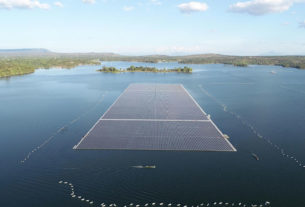On April 4-12, a disruption of Thailand’s gas supply from Myanmar will occur when their gas facilities shut down for yearly maintenance. The Thai electric utility company will adjust for the temporary disruption by increasing usage of existing fuel oil and diesel plants, a spokesman said.
Thailand gets 70 percent of its energy supply from natural gas, which mainly comes from the Gulf of Thailand. However, about a fourth of Thailand’s natural gas is imported from Myanmar. The rest of Thailand’s energy is supplied by coal burning plants that provide about 20 percent, with the remaining 10 percent coming from dams and renewable energy sources.
The Thai government currently supports the building of “clean coal” technology to deal with the long-range problem of the natural gas running out, said Mr. Ditpong Potchana, vice governor of social affairs of the Electricity Generating Authority of Thailand (EGAT).
“Having to depend on importing natural gas to meet energy needs might lead to instability and threaten the security of the industry,” he said.
Mr. Ditpong said the most appropriate option to solve the energy problem was new power plant development, and seeking alternative renewable fuel to replace natural gas. The new development would be stabilizing the fuel supply to the electric power plants, and help prevent electric bills from spiraling upward.
The alternative to using existing natural gas is importing the expensive Liquified Natural Gas (LNG) which costs three times as much. Right now, about 25 percent of Thailand’s imported natural gas in LNG, but that percentage may double in the next 15 years, after the natural gas supply is gone
However, the Ministry of Power and the EGAT recognized that the coal importing would be the perfect solution now, because of more efficient technology. Many countries had been producing electricity from coal already, and it tends to produce a more effective energy ratio of converting coal to electricity, Mr. Ditpong said.
Future plans by the utility company include the purchase more of power from private small power plants or XPP, and buying hydropower from Laos.
The government will accelerate its timetable to examine the all power plants using diesel fuel to prepare for increased capacity, as the natural gas supply dips lower over the next decade. Cooperative efforts will be made with the Royal Irrigation Department, to increase drainage by using dams to generate electricity to reduce oil usage.
Currently Thailand has the capability to meet its energy demands as well as emergencies. The disruption of the Myanmar natural gas supply will result in the lost production of 6,000 MW, which would mainly affect power plants in west Thailand, Mr. Ditpong said.
During that period, the maximum need for electric power would be at 26,500 MW, so the EGAT has a backup system to prevent adverse effects such as a power failure, and has eight guidelines to cope with shortages, such as renewable diesel /oil fuel to replace the missing fuel supply to power plants.
In addition, the EGAT had postponed the maintenance of all the power plants during the Myanmar shutdown, Mr. Ditpong said, and coordinated with The Provincial Electricity Authorities and Metropolitan Power Board to prepare the plan of emergency power supply shutdown of 350 MW per unit.
Source: http://www.pattayadailynews.com/en/2013/02/21/thailand-will-run-out-of-gas-in-10-years/

